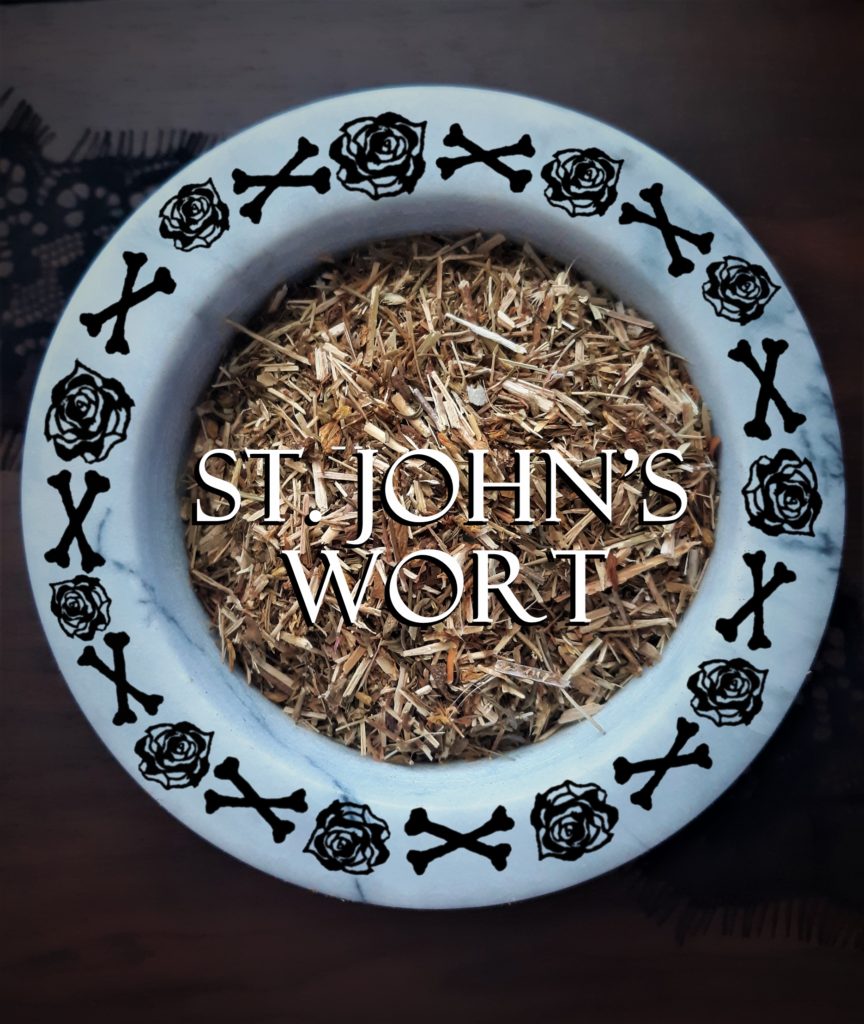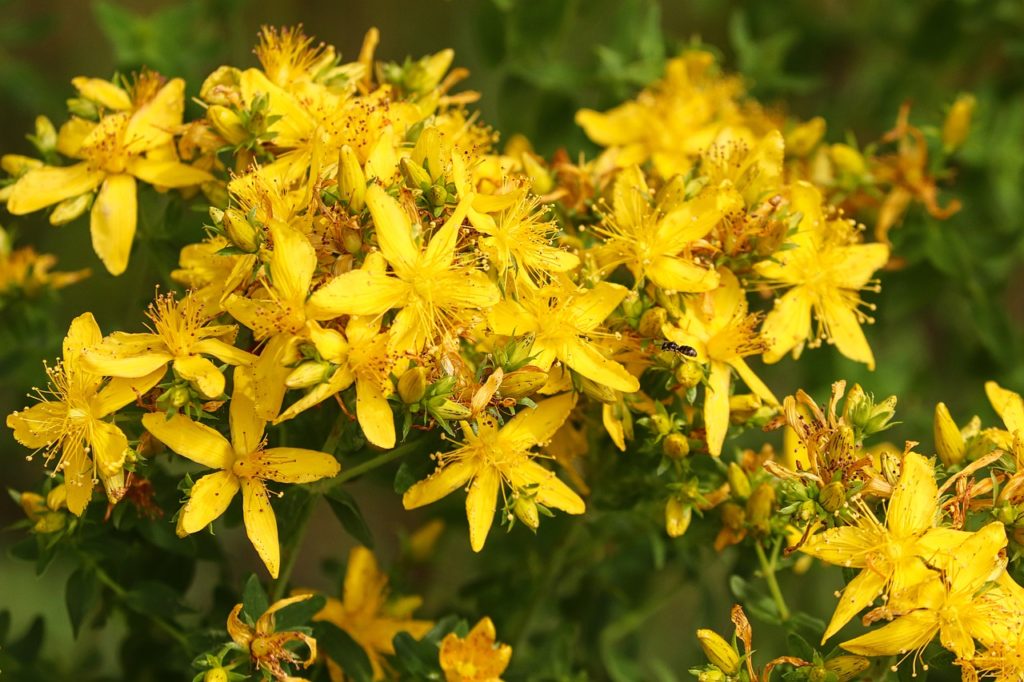
In the world of witchcraft, there are plenty of herbs used for protecting your space and aura.
But one herb, in particular, has amazing strength when it comes to purification, protection, and banishing.
This Th-HERBS-day we honor St. John’s Wort (Hypericum perforatum).
St. John’s Wort is an herb in the Hypericaceae family and is one of up to 700 species in this group.
The word “wort” is an old word meaning “herb,” which is why herbal names commonly include it like motherwort or liverwort.
Many herbalists swear by the healing effects of St. John’s Wort and it’s one of the oldest herbs used in medicine.
Today, St. John’s Wort is praised for its effect on depression and has often been prescribed over anti-depressants throughout Europe.
It can, however, be toxic to grazing animals, interfere with certain medications, and cause photosensitivity.
The essence of St. John’s Wort is extremely protective and can fill the aura with light and strength.
It’s often overlooked as an herb for protective cleanses, but it has more power than many commonly used cleansing herbs.

The History of St. John’s Wort
Early Greek and Roman physicians believed that St. John’s Wort was best used for dressing wounds.
This was concluded because the plant had an odd appearance of “bleeding” if the flowers were pinched or picked.
This was an old way of finding clues to what medicinal qualities a plant had based on its appearance and characteristics.
You can find more information about this method in The Doctrine of Signatures, by Scott Buchanan.
It was used to create dyes for both red and yellow colors and was even used to determine life expectancy in Welsh folk practices.
During the early days of Christianity, the plant was associated with St. John the Baptist.
This was because it was said to bloom first on his birthday, June 24, and to bleed red oil from its leaves on the day he was beheaded.
The plant was believed to have more medicinal potency if harvested on St. John’s Day.
St. John’s Wort has concentrated medicinal properties in its volatile oil, resins, tannins, and its dyes.
When picked or used in tinctures, this plant turns a distinctive red color.
The dye is what contains its antidepressant properties for humans and is commonly used for anxiety.
The tannins and oils contain astringent and antibacterial properties.
These properties include soothing gastritis, ulcers, nausea, and hemorrhoids.
Constellation Tarot Table Card Cloth Divination Velvet 60x60cm Black Square

Witchery With St. John’s Wort
St. John’s Wort is one of the most powerful herbs used in purification and protective ritual.
The shape of its five-petaled yellow flowers resembles the five-pointed star, which is common for Sun-ruled herbs.
In the pseudepigraphical text “The Testament of Solomon,” legend states that archangel Raphael gifted King Solomon with a magic ring.
The ring was engraved with the pentalpha (five-pointed star) and had the power to subdue all demons.
The five-pointed star, or pentagram, is one of the many protective Seals of Solomon.
The Seals of Solomon attribute to the protective powers of God’s light against the darker entities.
This protective power of God aligns with the properties of the Sun across many foundational belief systems.
The spirit of St. John’s Wort oversees the distribution of the Sun’s protective energy.
It can purify the auras of the living and cleanse the space it occupies, filling it with light and balanced vibrations.
Researchers have found the medicinal properties of St. John’s Wort help balance the nervous system, and fight bacteria.
This perfectly represents how St. John’s Wort works energetically.
The herb has perforated holes along the bottom of its leaves allowing the Sun’s light to pierce through it without causing damage.
Ironically, this observation of the perforated leaves translates to the photosensitivity it can cause in both humans and animals.
As you work with St. John’s Wort, you’ll notice that this is the same way in which its spirit brings in the Sun’s energy.
Penetrating through building walls, or the body’s skin, it fills spaces with protective light and pushes out energetic blockages.
The Green Witch Tarot by Ann Moura (English) Book & Merchandise Book

St. John’s Wort Energetic Properties
This list of Sst. John’s Wort properties is an extremely helpful guide to assist you in spell crafting and rituals.
The energy of the herb is heightened when planned carefully with corresponding days, seasons, zodiacs, etc.
Here are 18 energetic properties associated with St. John’s Wort:
1. Planet: Sun
2. Zodiac Sign: Leo
3. House: 5th
4. Element: Fire, Water
5. Gender Energy: Masculine
6. Chakra: Ajna/Third Eye (Indigo)
7. Archangel: Raphael
8. Deity: Helios (Greek), Baldur (Norse), Usil (Etruscan)
9. Sabbat: Litha
10. Season: Early Spring, Summer
11. Day: Sunday
12. Body: Heart, Back, Right Eye of Males, Left Eye of Females
13. Rune: Raidu, Kauna, Isa, Jera
14. Numerology: 1
15. Fae: Salamander
16. Major Arcana: The Sun, Strength
17. Minor Arcana: Wands
18. Cartomancy: Diamonds

Cultivating St. John’s Wort
If you live in planting zone 5, you’re likely to find St. John’s Wort growing all around your area.
It grows easily and can be very hardy in the wild, though it’s generally short-lived and considered a weed.
You can start growing it by seed, cuttings, or by dividing the herb in the fall.
Make sure to plan a space with either full or partial sun, it’s resilient and generally grows in any type of soil.
It makes for a lovely addition to native gardens because it can be easily managed and is not invasive.
If you plan to harvest St. John’s Wort for medicinal use, you can press the leaves for its oils or store them in a dark cool space.
You can add the oil to a carrier oil like olive oil or grapeseed oil and it will keep for up to two years.
Its oils will turn most carrier oils red as it ages.
Happy Th-HERBS-day!


Gypsy Chain, Rosary Style Necklace
